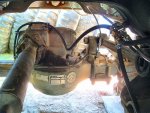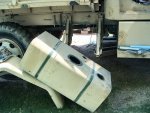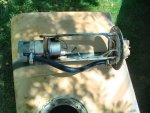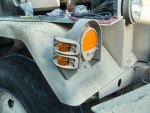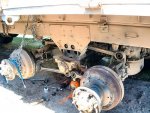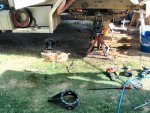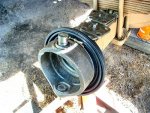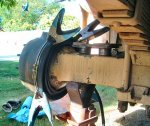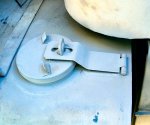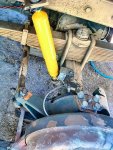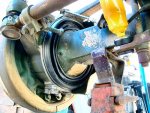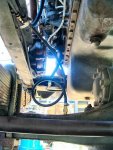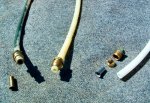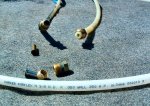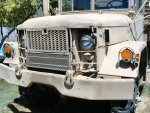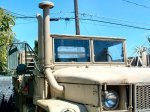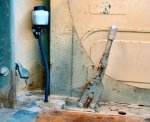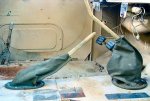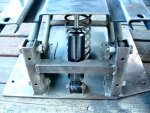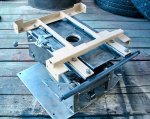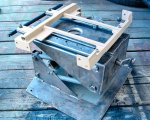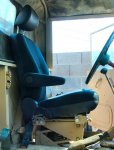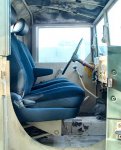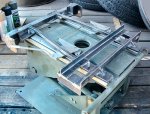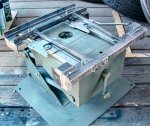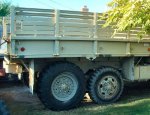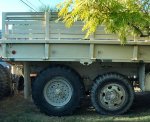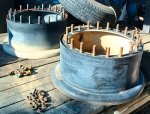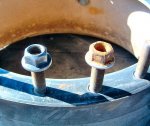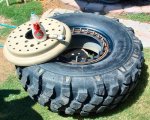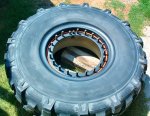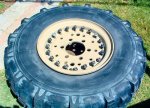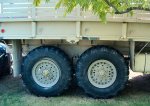Received the final 8 torque rod bushings late Thursday, so I spent all day Friday pressing them back into the torque rods, then reassembling the entire rear suspension...thank God for whomever invented air tools! I installed 1/4-inch fuel line as axle remote breather lines, connected them to a "T" fitting, and ran the length inside the frame to connect with the front axle remote breather hose when I get it installed later this week. It will terminate somewhere in the engine compartment, with a small fuel filter on the end to keep dirt & contaminants out.
I didn't like the cracking starting on the rear brake lines, so I went to my local All-Hose shop and had them fabricate 2 braided stainless steel replacements while I waited; the price was cheaper than ordering NOS replacements. Reconnected both driveshafts and torqued/greased them properly.
Finished installing all new coolant hoses and received a new thermostat/gasket from Erik's; I'll install it when I'm through flushing the cooling system. Changed the oil filters and drained the old oil out; I noticed that the 2 oil pan drain plugs didn't have gaskets so I purchased 2 copper crush washers from Erik's and installed them to prevent leaks. Then refilled with new 15W-40 diesel oil. I also changed the lubricants in the transfer case & transmission, as well as the steering box. I used Valvoline Synthetic 75W-90 (NAPA #975) in all of these, as they are MT-1 compliant and "Yellow Metal Friendly." I also stared cleaning off Zerk fittings in preparation for fresh applications of grease.
I removed the fuel tank & dismantled it to inspect the interior, and was pleasantly surprised to find NO RUST nor any other contaminants/crap inside. The lift pump looked great, so I replaced the rubber hose on it with a new one and cleaned it up in preparation for reinstallation. I used some industrial-strength detergent inside the tank to clean out any possible contaminants, then flushed it thoroughly and let it dry for more than 24 hours (not hard in such a dry climate here). I also disconnected the fuel supply line from the primary filter, and the return line from the secondaries, in order to flush out the lines with solvent and compressed air...nothing but diesel fuel came out, so no worries there.
When I drained about 25 gallons of diesel fuel out of it, the fuel came out looking great. I had added some Biocide when I brought it home, and it looked like it did its job! I filtered it and placed it in a clean 55-gallon drum while I cleaned the tank. Once the tank was cleaned & dried, I reinstalled everything with fresh gaskets & sealant, then pumped the re-filtered diesel fuel back into the tank, while adding a little fuel treatment & a little more Biocide. I turned on the Accessory switch, cracked the primary fuel filter drain petcock, and instantly it started spewing clean diesel fuel with great pressure! WHEW! I cracked the secondaries and after a few minutes started getting fuel flowing through there too.
I hope to be able to fire her up tomorrow in order to check for leaks/problems with all the new fuel lines I installed, as well as flush out the cooling system and put in fresh coolant.
I've also been working on modifying the turn signal housings to accept 2 LED marker lights; one for parking/marker lighting and the lower one for turn signalling, to be fully DOT compliant in case I run across a revenue-hungry jurisdiction. All wiring is soldered together with the military-style connectors, and connected inline with appropriate stock wires. The turn signals themselves have been replaced with LED units I bought from a Classifieds vendor.
The light at the end of the tunnel is getting closer & closer!!!



